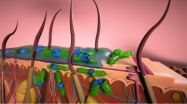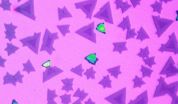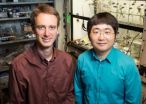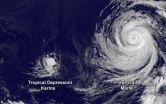(Press-News.org) CAMBRIDGE, MA -- Researchers from MIT, Pennsylvania State University, and Carnegie Mellon University have devised a new way to separate cells by exposing them to sound waves as they flow through a tiny channel. Their device, about the size of a dime, could be used to detect the extremely rare tumor cells that circulate in cancer patients' blood, helping doctors predict whether a tumor is going to spread.
Separating cells with sound offers a gentler alternative to existing cell-sorting technologies, which require tagging the cells with chemicals or exposing them to stronger mechanical forces that may damage them.
"Acoustic pressure is very mild and much smaller in terms of forces and disturbance to the cell. This is a most gentle way to separate cells, and there's no artificial labeling necessary," says Ming Dao, a principal research scientist in MIT's Department of Materials Science and Engineering and one of the senior authors of the paper, which appears this week in the Proceedings of the National Academy of Sciences.
Subra Suresh, president of Carnegie Mellon, the Vannevar Bush Professor of Engineering Emeritus, and a former dean of engineering at MIT, and Tony Jun Huang, a professor of engineering science and mechanics at Penn State, are also senior authors of the paper. Lead authors are MIT postdoc Xiaoyun Ding and Zhangli Peng, a former MIT postdoc who is now an assistant professor at the University of Notre Dame.
The researchers have filed for a patent on the device, the technology of which they have demonstrated can be used to separate rare circulating cancer cells from white blood cells.
To sort cells using sound waves, scientists have previously built microfluidic devices with two acoustic transducers, which produce sound waves on either side of a microchannel. When the two waves meet, they combine to form a standing wave (a wave that remains in constant position). This wave produces a pressure node, or line of low pressure, running parallel to the direction of cell flow. Cells that encounter this node are pushed to the side of the channel; the distance of cell movement depends on their size and other properties such as compressibility.
However, these existing devices are inefficient: Because there is only one pressure node, cells can be pushed aside only short distances.
The new device overcomes that obstacle by tilting the sound waves so they run across the microchannel at an angle — meaning that each cell encounters several pressure nodes as it flows through the channel. Each time it encounters a node, the pressure guides the cell a little further off center, making it easier to capture cells of different sizes by the time they reach the end of the channel.
In this study, the researchers first tested the system with plastic beads, finding that it could separate beads with diameters of 9.9 and 7.3 microns (thousandths of a millimeter) with about 97 percent accuracy. They also devised a computer simulation that can predict a cell's trajectory through the channel based on its size, density, and compressibility, as well as the angle of the sound waves, allowing them to customize the device to separate different types of cells.
To test whether the device could be useful for detecting circulating tumor cells, the researchers tried to separate breast cancer cells known as MCF-7 cells from white blood cells. These two cell types differ in size (20 microns in diameter for MCF-7 and 12 microns for white blood cells), as well as density and compressibility. The device successfully recovered about 71 percent of the cancer cells; the researchers plan to test it with blood samples from cancer patients to see how well it can detect circulating tumor cells in clinical settings. Such cells are very rare: A 1-milliliter sample of blood may contain only a few tumor cells.
"If you can detect these rare circulating tumor cells, it's a good way to study cancer biology and diagnose whether the primary cancer has moved to a new site to generate metastatic tumors," Dao says. "This method is a step forward for detection of circulating tumor cells in the body. It has the potential to offer a safe and effective new tool for cancer researchers, clinicians and patients," Suresh says.
INFORMATION:
The research was funded by the National Institutes of Health and the National Science Foundation.
Written by Anne Trafton, MIT News
Sorting cells with sound waves
2014-08-26
ELSE PRESS RELEASES FROM THIS DATE:
Introducing the multi-tasking nanoparticle
2014-08-26
(SACRAMENTO, Calif.) — Kit Lam and colleagues from UC Davis and other institutions have created dynamic nanoparticles (NPs) that could provide an arsenal of applications to diagnose and treat cancer. Built on an easy-to-make polymer, these particles can be used as contrast agents to light up tumors for MRI and PET scans or deliver chemo and other therapies to destroy tumors. In addition, the particles are biocompatible and have shown no toxicity. The study was published online today in Nature Communications.
"These are amazingly useful particles," noted co-first author ...
HIV antibodies block infection by reservoir-derived virus in laboratory study
2014-08-26
WHAT:
A laboratory study led by scientists from the National Institute of Allergy and Infectious Diseases, part of the National Institutes of Health (NIH), lends further weight to the potential effectiveness of passive immunotherapy to suppress HIV in the absence of drug treatment. Passive immunotherapy for HIV is an experimental strategy that involves periodically administering broadly neutralizing HIV-specific antibodies (bNAbs) to control the virus. It would be advantageous to control HIV without antiretroviral drugs because of their cost, the potential for cumulative ...
Breakthrough antibacterial approach could resolve serious skin infections
2014-08-26
Like a protective tent over a colony of harmful bacteria, biofilms make the treatment of skin infections especially difficult. Microorganisms protected in a biofilm pose a significant health risk due to their antibiotic resistance and recalcitrance to treatment, and biofilm-protected bacteria account for some 80 percent of total bacterial infections in humans and are 50 to 1,000 times more resistant to antibiotics than simpler bacterial infections.
"In essence, we may have stumbled onto a magic bullet," said David Fox, a Los Alamos National Laboratory researcher on the ...
Scientists craft atomically seamless, thinnest-possible semiconductor junctions
2014-08-26
Scientists have developed what they believe is the thinnest-possible semiconductor, a new class of nanoscale materials made in sheets only three atoms thick.
The University of Washington researchers have demonstrated that two of these single-layer semiconductor materials can be connected in an atomically seamless fashion known as a heterojunction. This result could be the basis for next-generation flexible and transparent computing, better light-emitting diodes, or LEDs, and solar technologies.
"Heterojunctions are fundamental elements of electronic and photonic devices," ...
Personal protective equipment is critical but not enough to shield health care workers from Ebola
2014-08-26
Personal protective equipment is critical but not enough to shield health care workers from Ebola*
Free content
Personal protective equipment designed to shield health care workers from contaminated body fluids of Ebola patients is not enough to prevent transmission, according to a commentary being published early online today in Annals of Internal Medicine. Despite the known effectiveness of barrier protection in blocking Ebola transmission, infections among health care workers have played a major role in outbreaks. William A. Fischer II, MD from the University of North ...
Challenges ahead in improving child health by increasing access to sanitation in India
2014-08-26
A study published in this week's PLOS Medicine on large-scale rural sanitation programs in India highlights challenges in achieving sufficient access to latrines and reduction in open defecation to yield significant health benefits for young children.
The researchers, led by Sumeet Patil from the School of Public Health, University of California at Berkeley, and the Network for Engineering and Economics Research and Management in Mumbai, India conducted a cluster randomised controlled trial in 80 rural villages in the Indian state of Madhya Pradesh to measure the effect ...
A glucose meter of a different color provides continuous monitoring
2014-08-26
CHAMPAIGN, Ill. — University of Illinois engineers are bringing a touch of color to glucose monitoring.
The researchers developed a new continuous glucose monitoring material that changes color as glucose levels fluctuate, and the wavelength shift is so precise that doctors and patients may be able to use it for automatic insulin dosing - something not possible using current point measurements like test strips.
"There are significant limitations to current continuous glucose monitoring technologies," said study leader Paul Braun, a professor of materials science and ...
NASA's TRMM and Aqua satellites gaze into Hurricane Cristobal
2014-08-26
NASA's TRMM and Aqua satellites have been providing views of the outside and inside of Hurricane Cristobal as it heads for Bermuda. The National Hurricane Center posted a Tropical Storm Watch for Bermuda as Cristobal heads in that direction.
Strong winds and flooding associated with Tropical Storm Cristobal caused deaths in the Dominican Republic, Haiti, and Jamaica. The Tropical Rainfall Measuring Mission or TRMM satellite captured rainfall data from Cristobal on August 24, 2014 at 1150Z (7:50 a.m. EDT). Light to moderate rainfall was occurring throughout much of the ...
Satellite shows Hurricane Marie about to swallow Karina
2014-08-26
Massive Hurricane Marie appears like a giant fish about to swallow tiny Tropical Depression Karina on satellite imagery today from NOAA's GOES-West satellite. Karina, now a tropical depression is being swept into Marie's circulation where it is expected to be eaten, or absorbed.
An image from NOAA's GOES-West satellite on Aug. 26 at 8 a.m. EDT shows Karina being drawn into the powerful and large circulation of Hurricane Marie to the east of the depression. The image was created by NASA/NOAA's GOES Project at NASA's Goddard Space Flight Center in Greenbelt, Maryland.
Forecasters ...
NASA sees huge Hurricane Marie slam Socorro Island
2014-08-26
NASA's Terra satellite passed over Hurricane Marie when its eye was just to the west of Socorro Island in the Eastern Pacific. Marie's eye may have been near the island, but the storm extended several hundreds of miles from there.
On Aug. 25 at 18:20 UTC (2:20 p.m. EDT) the Moderate Resolution Imaging Spectroradiometer or MODIS instrument aboard NASA's Terra satellite captured Hurricane Marie's center just west of Socorro Island. The image showed Marie's tightly wound center and eye. A thick band of powerful thunderstorms surrounded the center of circulation, and bands ...






